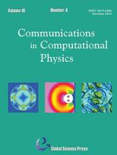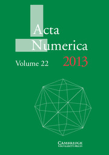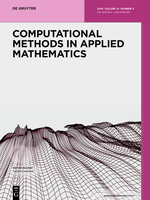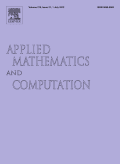
Communications in Computational Physics
Scope & Guideline
Unlocking New Dimensions in Computational Research.
Introduction
Aims and Scopes
- Numerical Methods for Differential Equations:
The journal presents research on various numerical schemes including finite element, finite difference, and spectral methods tailored for solving differential equations that model physical phenomena. - Computational Fluid Dynamics (CFD):
A significant portion of the publications is dedicated to CFD, addressing both incompressible and compressible flows, as well as multiphase and reactive flows. - Machine Learning and Data-Driven Approaches:
There is a growing emphasis on integrating machine learning techniques with traditional computational methods to enhance modeling accuracy and efficiency in solving partial differential equations. - Stochastic and Multiscale Modeling:
The journal includes studies on stochastic processes and multiscale methods, reflecting the complexity of physical systems that exhibit variability and scale-dependent behaviors. - Phase-Field and Interface Problems:
Research focusing on phase-field methods for modeling interface dynamics in materials science and fluid dynamics is a recurring theme, highlighting the interplay between computational techniques and physical modeling. - Optimization and Control in Computational Physics:
Papers explore optimization strategies and control methods applicable to physical systems, aiming to improve performance in simulations and real-world applications.
Trending and Emerging
- Integration of Machine Learning Techniques:
There is a significant increase in papers that integrate machine learning with traditional computational physics, enhancing predictive capabilities and model efficiency. - High-Order and Adaptive Numerical Methods:
The trend towards high-order and adaptive numerical methods is prominent, as researchers aim for improved accuracy and stability in simulations of complex physical systems. - Data Assimilation and Inversion Techniques:
An emerging focus on data assimilation methods indicates a growing interest in improving models through real-time data integration, which is crucial for applications in weather forecasting and environmental modeling. - Multiscale and Hybrid Modeling Approaches:
Papers addressing multiscale modeling techniques that can bridge different physical scales and phenomena are becoming more common, reflecting the complexity of real-world systems. - Computational Approaches to Quantum Mechanics:
There is a noticeable trend towards applying computational methods to quantum mechanics and related fields, which aligns with advancements in quantum computing and simulation.
Declining or Waning
- Classical Methods in Computational Physics:
There has been a noticeable reduction in the publication of papers focused solely on classical numerical methods without innovative enhancements or integrations with modern techniques. - Simplified Models for Complex Systems:
Research that relies on overly simplified models to represent complex physical systems appears to be decreasing, as there is a shift towards more detailed and accurate representations that account for multiple interacting factors. - Low-Order Numerical Schemes:
The focus on low-order numerical methods is waning, as the community increasingly favors high-order and adaptive methods that yield greater accuracy and efficiency. - Theoretical Studies with Limited Computational Applications:
Papers that present theoretical constructs without substantial computational validation or application are seeing reduced interest, reflecting a trend towards more applied computational research.
Similar Journals

ACTA NUMERICA
Pioneering Research in Numerical Methodologies.ACTA NUMERICA, published by Cambridge University Press, stands as a premier journal in the fields of Mathematics and Numerical Analysis since its inception in 1992. With an impressive Scopus ranking that places it in the 99th percentile and a prestigious Q1 category status in both Mathematics (miscellaneous) and Numerical Analysis for 2023, it has established itself as a leading platform for cutting-edge research. The journal's scope encompasses a wide range of numerical methods and computational techniques that address complex mathematical problems, making it an essential resource for researchers, professionals, and students alike. Although it does not provide Open Access, its commitment to quality and innovation in the mathematical sciences continues to attract submissions from around the globe. Published in the United Kingdom, ACTA NUMERICA remains a vital channel for disseminating significant advancements in numerical methodologies.

Mathematics in Engineering
Exploring the synergy between mathematics and engineering.Mathematics in Engineering, published by the American Institute of Mathematical Sciences (AIMS), is a premier open-access journal that has been advancing the field of mathematical sciences since its inception in 2019. With a focus on interdisciplinary applications, this journal embraces a broad spectrum of topics within analysis, applied mathematics, and mathematical physics. It has quickly garnered recognition, achieving notable rankings such as Q1 status in Analysis and Mathematical Physics, and Q2 in Applied Mathematics, according to the 2023 category quartiles. The journal’s Scopus rankings further underline its commitment to quality, with impressive placements reflecting its growing influence in the mathematical community. Accessible to all, Mathematics in Engineering aims to provide a platform for the dissemination of innovative research findings and methodologies, fostering collaboration among researchers, professionals, and students in the mathematical domain. For those looking to contribute to or deepen their understanding of current mathematical applications in engineering, this journal is an essential resource.

ELECTRONIC TRANSACTIONS ON NUMERICAL ANALYSIS
Exploring Innovative Techniques in Numerical AnalysisELECTRONIC TRANSACTIONS ON NUMERICAL ANALYSIS, published by Kent State University, is an esteemed journal dedicated to the field of numerical analysis and applied mathematics. With its ISSN 1068-9613, this journal serves as a vital resource for researchers and practitioners engaged in the advancement of numerical techniques and their applications, offering insights that bridge theoretical foundations and practical implementations. The journal, which displays robust visibility in the academic community, currently holds a commendable rank of Q2 in both the Analysis and Applied Mathematics categories as of 2023, illustrating its significance within the research landscape. Though subscription-based access options are not specified, the journal consistently endeavors to disseminate cutting-edge research findings to its audience, enriching the scholarly dialogue in the mathematical sciences. Spanning from 1996 to 2024, it has fostered a platform for dynamic exchange among thinkers across the globe, making it an essential publication for those seeking to influence and innovate within this critical area of study.

COMPUTATIONAL MATHEMATICS AND MATHEMATICAL PHYSICS
Pioneering Numerical Analysis and Applied MathematicsCOMPUTATIONAL MATHEMATICS AND MATHEMATICAL PHYSICS is a prestigious journal published by PLEIADES PUBLISHING INC, dedicated to advancing the fields of computational mathematics and mathematical physics. With an ISSN of 0965-5425 and an E-ISSN of 1555-6662, the journal has established its importance within the academic community since its inception in 1985. It is classified in the third quartile (Q3) for computational mathematics in 2023, and while currently it does not offer open access options, it remains a valuable resource for researchers seeking to disseminate their findings and engage with cutting-edge developments in the field. The journal encompasses a broad spectrum of topics, including numerical analysis, applied mathematics, and the intersection of physics and computational techniques, highlighting its relevance in addressing complex problems in both theoretical and applied contexts. Scholars will find a platform that not only promotes rigorous research but also encourages collaboration and innovation within the scientific community.

Journal of Mathematical Fluid Mechanics
Advancing Knowledge at the Intersection of Mathematics and Fluid MechanicsThe Journal of Mathematical Fluid Mechanics, published by SPRINGER BASEL AG, is a prestigious academic journal dedicated to the study of fluid dynamics through the lens of mathematics. With its ISSN 1422-6928 and E-ISSN 1422-6952, this journal has firmly established itself in the academic community since its inception in 2004, converging knowledge across various mathematical disciplines until 2024. Recognized in the top Q1 quartile rankings for Applied Mathematics, Computational Mathematics, Condensed Matter Physics, and Mathematical Physics as of 2023, it reflects a strong commitment to high-quality research and innovation. The journal features a variety of research articles, reviews, and theoretical frameworks, serving as an essential resource for researchers, professionals, and students eager to explore the mathematical principles underlying fluid mechanics. While it does not offer open access, the impact of its contributions resonates within interdisciplinary fields, advancing both theoretical insights and practical applications.

Communications on Applied Mathematics and Computation
Fostering Excellence in Applied Mathematics and ComputationCommunications on Applied Mathematics and Computation is a distinguished journal published by SpringerNature, dedicated to advancing the fields of Applied Mathematics and Computational Mathematics. With its ISSN 2096-6385 and E-ISSN 2661-8893, the journal has established itself as a critical platform for researchers seeking to disseminate their findings and engage with contemporary mathematical challenges. Recognized in the Q2 quartile of both Applied Mathematics and Computational Mathematics categories for 2023, it ranks impressively within its field, holding the 278th position in a pool of 635 journals for Applied Mathematics and the 89th out of 189 for Computational Mathematics, indicative of its scholarly impact. The journal facilitates open access to a plethora of pioneering research, promoting collaboration and innovation in a global academic community. With a commitment to high-quality publications from 2019 through 2024, Communications on Applied Mathematics and Computation serves as an essential resource for scholars and practitioners aiming to bridge theory and practical applications in mathematics.

Computational Methods in Applied Mathematics
Advancing Solutions Through Applied MathematicsComputational Methods in Applied Mathematics is a premier academic journal published by WALTER DE GRUYTER GMBH, based in Germany. With its ISSN 1609-4840 and E-ISSN 1609-9389, this journal serves as a crucial platform for the dissemination of cutting-edge research and innovations in the fields of Applied Mathematics, Computational Mathematics, and Numerical Analysis. Notably, it has been recognized in 2023 with a Q2 ranking in its category quartiles, marking it as a significant contributor in its discipline. Spanning from 2001 to 2024, it fosters interdisciplinary collaboration and exploration of computational methodologies that solve complex mathematical problems. Though it operates on a traditional access model, its relevance is underscored by its Scopus rankings, which place it among the notable leaders in its area. As a trusted source of scholarly articles, Computational Methods in Applied Mathematics is an essential resource for researchers, professionals, and students aiming to stay abreast of advancements and discussions that shape the future of applied mathematics.

APPLIED MATHEMATICS AND COMPUTATION
Catalyzing Progress in Computational MethodsApplied Mathematics and Computation is a premier journal dedicated to the dissemination of high-quality research in the field of applied mathematics and computational methods. Published by Elsevier Science Inc, this influential journal has established itself as a key resource for researchers, professionals, and students interested in mathematical modeling, numerical analysis, computational algorithms, and their applications across various disciplines. With an impressive impact factor reflecting its scholarly credibility, it holds a distinguished position in the Q1 quartile for both applied and computational mathematics as of 2023, ranking #31/635 and #12/189 in Scopus categories respectively, thereby indicating its significant impact on the academic community. The journal encompasses a broad spectrum of topics, encouraging original research, critical reviews, and innovative methodologies that address real-world challenges. Although it currently does not offer open access options, it remains a cornerstone publication for those at the forefront of mathematical research, continuously bridging theory with practical computation since its inception in 1975.

Numerical Mathematics-Theory Methods and Applications
Unveiling the Power of Numerical TechniquesNumerical Mathematics: Theory Methods and Applications, published by GLOBAL SCIENCE PRESS, stands as a pivotal journal in the fields of applied and computational mathematics, control and optimization, as well as modeling and simulation. With an ISSN of 1004-8979 and an E-ISSN of 2079-7338, this journal has been committed to disseminating high-quality research since its establishment in 2010, curating contributions that reflect the latest advancements in numerical methodologies and their diverse applications. As a Q2 journal in its category for 2023, it ranks favorably in the Scopus metrics, with notable positions in various mathematical disciplines. Although it does not currently provide open access, it remains an essential resource for researchers and professionals seeking to deepen their understanding of numerical methods and their applications. The journal’s esteemed reputation, coupled with its strategic focus on emerging trends in mathematics, makes it an invaluable platform for scholars who wish to contribute to and stay informed about cutting-edge developments in this dynamic field.

NUMERICAL METHODS FOR PARTIAL DIFFERENTIAL EQUATIONS
Exploring innovative solutions for complex equations.Numerical Methods for Partial Differential Equations is a prestigious academic journal published by Wiley, dedicated to advancing the field of numerical analysis and computational mathematics. With a prominent standing reflected in its Q1 rankings across multiple categories including Analysis, Applied Mathematics, Computational Mathematics, and Numerical Analysis, this journal serves as a vital resource for researchers, professionals, and students alike. Since its inception in 1985, NUMERICAL METHODS FOR PARTIAL DIFFERENTIAL EQUATIONS has consistently published high-quality, peer-reviewed articles that explore innovative numerical techniques and their applications across disciplines. The journal is indexed in leading databases, ensuring broad visibility and access for its contributors. Aimed at fostering cutting-edge research, it invites submissions that provide new insights and methodologies for solving complex partial differential equations, making it an essential source for anyone interested in the intricacies of mathematical analysis and computational techniques.